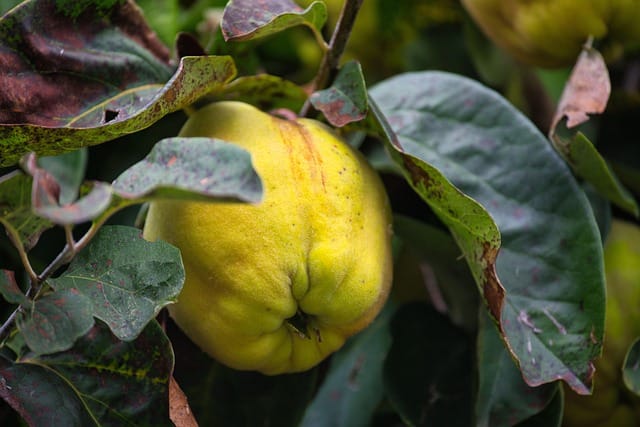
Quince Farming fruit seems like a fuzzy-skinned cross between a squat pear and an apple. A fruit can reach 10 pounds in weight and a diameter of up to 5 inches. We can eat quince fruit raw, but it is very tart. In such a way, you can cook quince commonly and make it into quince jelly, add it to fruit compotes, or make it into crisps, tarts, and cobblers.
Quince fruit is an autumn plant. This fruit plant is a vast shrub that grows up to 10 feet wide and 10 feet tall. Other than this, a ripe quince fruit has a hint of green with yellow skin. The flesh is tiny seeds with a yellowish-white color, like apple seeds, in the core.
Quince farming requires the most important equipment, which plays a major role in agro-processing. Equipment, harvesters, and tractors are the main tools in quince cultivation; hence, we suggest the Eicher tractor.
Ideal Climate and Site for Growing Quince Fruit
- Farmers typically grow quince in zones 5 to 9. Peach is not harder than quince but less hard than a pear. This fruit belongs to a botanical subfamily similar to the pear.
- Plant the plant in full sun.
- Quince fruit plants grow in compost-rich, well-drained soil with a pH of about 6.5, slightly acidic soil.
- Plant the plant in a warm, sheltered location close to a wall; then, it can receive reflected heat.
- You should avoid planting the quince fruit in places where frost and cold air settle.
Planting Quince
- Farmers can plant quinces during the growing season, but avoid planting in dry or hot weather.
- The plant is dormant and optimal for early spring planting.
- Full sun is required to prepare the planting site to protect it from the wind and prevailing winds.
- Work well-rotted compost or manure into the soil.
- Again, dig a pit half as deep and twice as wide as the roots of the plant. Pour one cup of all-purpose fertilizer at the bottom of the hole.
- Set the quince plant in the hole, then level the soil mark on the stem from the nursery pot with the surrounding soil.
- Remove all burlap and twine from bolted and burlapped trees. Spread the roots in all directions.
- Refill the hole with half old compost and half native soil or commercial planting mix.
- Be firm in the soil; consequently, there will be no air pockets between the roots. Build a slight clay basin around the trunk to keep the soil in the water during watering time.
- Farmers should thoroughly water with a high-phosphorus liquid starter fertilizer after planting.
Container that Grows the Quince
- Farmers can grow the quince 18 inches deep and wide or in a larger container.
- Plant the tree in a commercial organic potting mix.
- Keep the soil moist, but not soggy.
- Plant the container-grown quince with an all-purpose fertilizer that is higher in potassium.
- You should keep the report of the tree after 2 years in a container that is 24 inches deep and wide.
- Prune the top and roots each winter to keep quince fruit small.
Quince Nutrients, Care, and Water Requirement
- Water the quince plant regularly for good production of fruit. Farmers should keep the soil moist.
- Plant the quince fruit with a general compound fertilizer in early spring before growth begins. Avoid planting the quince fruit where there may be a problem with fire. The lush new leafy growth is prone to fire, a bacterial disease.
- Around mulch, the plants have aged compost in mid-spring. Aged compost mulch will help keep weeds down and the soil healthy.
- Quince flowers occur in late spring. Therefore, it is less susceptible to frost damage than other fruit trees. Cover flowering or budding plants with a plant blanket or burlap if frost threatens.
Training and Pruning Quince
- Quince is usually trained as a shrub, but you can train it as a small tree.
- In the first year, prune the quince to an open center by cutting the center to about 24 inches.
- Next, choose the scaffolding branch. Trim these again into two buds and remove all other branches.
- You need to establish quince plants that do not require much pruning. Prune this fruit in winter to keep the plant open to wind and sunlight. In addition, you should remove any diseased or broken branches.
- Quince is mainly at the tips of growth from the previous summer. Prune quince like a tip-bearing apple.
- If the lateral shoots are less than 9 inches long, they can be left uncut. These shoots will flower and bear fruit at the end of their growth in the next season. You should cut the long side shoots back to about 6 inches long.
In completing the guidelines for this farming, we came here to inform you of some important points about quince farming. In such a way, we suggest the Farmtrac tractor. Apart from this, farming needs various equipment, such as a rotary tiller, a cultivator, and many other implements.
For more information regarding quince farming, stay tuned with us.


